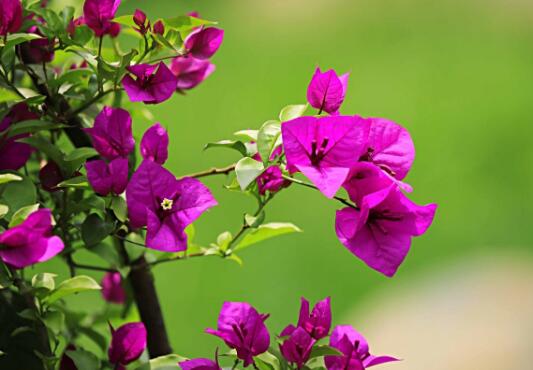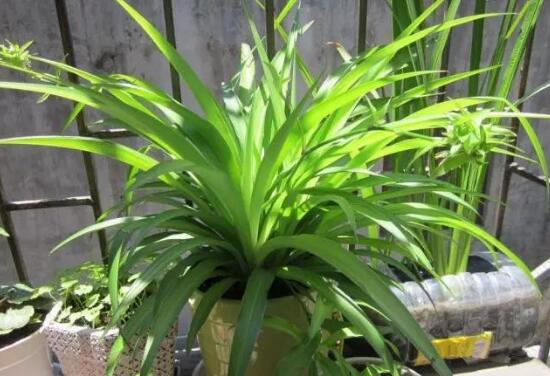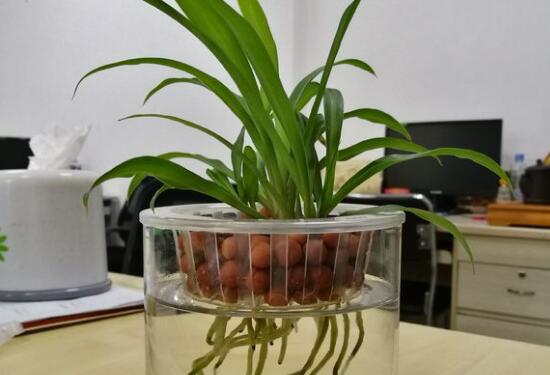How to raise the bare-leaf cotyledon flower, the culture method and matters needing attention / sufficient light
Pleurotus glabra is a kind of flower plant native to Brazil, which was introduced to China, and can be seen in many parts of our country. But if you want to raise it well, there are still many things to pay attention to. About how to raise bare-leaf flowers? What are the breeding methods and matters needing attention of bare-leaf cotyledon? Next, the editor will take you to learn about it.
First, how to raise bare-leaf flowers and understand their habits

If we want to know how to raise the light-leaf flower, we must first understand its growth habits. It prefers a warm and humid environment and is less resistant to cold, so we must control the temperature in the process of breeding and do not let the temperature too low. In addition, daily water and fertilizer should also be released as required, so that it can grow better.
2. Culture methods and matters needing attention of glabrous cotyledon
1. Soil, loose and good drainage
Bare-leaf cotyledon is not strict with soil, but it is afraid of stagnant water, so we had better choose loose, fertile and well-drained soil. Generally, we can choose 4 parts of humus soil, 4 parts of garden soil and 2 parts of sand. We can also use sun-dried pond mud mixed with some coal cake dregs as basin soil.
two。 Fertilizing, avoid thick fertilizer
Fertilizer is one of the main nutrients in the growth process of glabrous cotyledon, especially after entering the growing period, its demand for fertilizer is still very high, basically every 7-10 days. However, there is one thing we should pay attention to when applying fertilizer, that is, the fertilizer must be diluted with water before fertilization. If the fertilizer concentration is too high, it is easy to burn the plant.
3. Temperature, 15: 30 ℃
We also need to pay attention to the temperature control when we breed the light-leaf flower, because it can grow better only if it grows at a suitable ambient temperature. Its suitable temperature is between 15 and 30 ℃. It can withstand a high temperature of 35 ℃ in summer and an ambient temperature of no less than 5 ℃ in winter.
4. Moisture, avoid stagnant water
In the cultivation methods and matters needing attention, watering is also a point that needs to be paid attention to. It prefers a warm and humid environment, so we should water the soil frequently in the process of breeding so that the soil can keep a certain degree of moisture so that it can grow better. However, the bare leaf flower is not resistant to waterlogging, so we should control the amount of water.
5. Light, not less than 8 hours per day
The light-leaf flower is a kind of positive flower, so it is more light-loving. If there is not enough light in the growth process, it will lead to its growth weakness, affecting the bud and flowering. So we should keep enough light when we breed, and it is best to spend no less than 8 hours a day.
6. Pruning can reduce nutrient consumption
Phyllanthus glabra is a kind of plant with fast growth rate, so we should prune it regularly in the process of growth, which can promote the growth of lateral branches and produce more flower branches. And after each flowering, we also need to clean up the residual flowers in time to reduce the consumption of nutrients.
7. Diseases and insect pests should be dealt with in a timely manner
In the process of the growth of glabrous cotyledon, if we are not careful enough, it is easy to have diseases and insect pests and other problems, this kind of problem is very harmful to the plant, so we must deal with it in time when it is found. For specific treatment methods, you can refer to the article on pest and disease control of glabrous cotyledon, which is introduced in detail.
Culture methods and matters needing attention of glabrous cotyledon
Light leaf flower, also known as triangulated plum, plant adaptability, variety is very suitable for home breeding. Next, Xiaoqi will introduce the methods and matters needing attention in the cultivation of light-leaf cotyledons, and get to know them together.
First, the culture method of bare leaf flower.
1. Soil: the light leaf cotyledon does not have strict requirements on the soil, but it is afraid of stagnant water and is not resistant to waterlogging, so it is necessary to choose the cultivated soil with loose and good drainage. Generally, 4 parts of humus soil, 4 parts of garden soil and 2 parts of sand can be selected, and sun-dried pond mud mixed with some coal cake dregs can also be used as basin soil.
2. Temperature: the suitable temperature for the growth of glabrous cotyledon is 15: 30 ℃, among which it is 19: 30 ℃ from May to September and 13: 16 ℃ from October to April of the following year. When the temperature is above 35 ℃ in summer, shading or spraying water and ventilation should be taken properly, and the ambient temperature should be maintained at no less than 5 ℃ in winter, otherwise the long-term temperature below 5 ℃ will be easy to freeze and fall leaves.
3, light: light leaves and flowers like light, lack of light in the growing season will lead to plant growth weakness, affecting pregnant buds and flowering, winter should be placed in front of the southward window, and the light time should not be less than 8 hours, otherwise a large number of fallen leaves are easy to appear. Short-day flowers, the light time every day is controlled at about 9 hours, and it can bud and blossom after one and a half months.
4. Watering: at ordinary times, we should master the principle of "no dry, no watering, but thorough watering". Do not apply fertilizer during the water control period, so as not to burn the root system. In this way, it takes about a month to bud and blossom, and the flowers bloom neatly and flourish.
5. Fertilization: in order to make the flower blossom, we must ensure adequate nutrients, and fertilization should be timely, appropriate and rational use. In general, during the peak growth period from April to July, liquid fertilizer is applied every 7 to 10 days to promote plant growth. Fertilizer can be used with 10%-20% cooked bean cake, rapeseed cake water or human feces water. Since August, in order to promote the gestation of flower buds, fertilizer based on phosphate fertilizer has been applied every 10 days, and 20% liquid fertilizer such as rotten chicken, duck, pigeon dung and fish can be used. From October to mid-November, it is necessary to apply phosphate fertilizer every half a month, and the concentration of fertilizer and water is 30% to 40%. In the future, topdressing should be applied once after each flowering, so that the flowering period can be replenished continuously.
6. Changing the basin: due to long-term watering, fertilization and Rain Water erosion, the basin soil is easy to harden, so it is necessary to loosen the soil regularly and remove weeds in the basin soil at the same time to facilitate the growth of Pueraria lobata. Otherwise, basin soil hardening, stagnant water, easy to cause root rot or poor growth.
II. Matters needing attention in the culture of glabrous cotyledon
Due to slow growth or dormancy of plants in summer and winter, fertilization should be stopped to avoid fertilizer damage. Do not apply thick fertilizer or raw fertilizer (not fully mature organic fertilizer) to prevent root damage, leaf coke shedding, or even the death of the whole plant. It needs to be moved indoors in the cold winter, otherwise it will cause frostbite.
The above is the introduction of glabrous cotyledon culture methods and matters needing attention, hoping to help you better cultivate glabrous cotyledon, and friends who want to know more about glabrous cotyledon continue to pay attention to us.
How to raise the hundred-day chrysanthemum, the breeding methods and matters needing attention / sufficient light
Hundred-day chrysanthemum is a kind of flower plant native to Mexico, which is highly ornamental, and there are many people who raise it in our country, but if we want to raise it well, there are still a lot of places to pay attention to. About how to raise a hundred-day chrysanthemum? What are the breeding methods and points for attention of hundred-day chrysanthemum? Next, the editor will take you to learn about it.
First, how to raise the hundred-day chrysanthemum and understand the habits
If you want to know how to raise a hundred-day chrysanthemum, first of all, we have to understand its growth habits. This plant likes a sunny environment, so we should keep it in sufficient light when we breed it. In addition to daily watering, fertilization and other aspects also need to be in strict accordance with the requirements. Details are introduced below, let's take a look.
2. Culture methods and matters needing attention of hundred-day chrysanthemum
1. Sandy soil
Before we breed the hundred-day chrysanthemum, we first need to choose the soil, which is a step to lay a good foundation, so we must choose the right one. Hundred-day chrysanthemum prefer loose and fertile sandy soil, which has good drainage and air permeability, which can better absorb nutrients and is not prone to stagnant water.
two。 Temperature, 15 ℃-20 ℃
If you want zinnia to thrive, you need to let it grow at a suitable ambient temperature, which is between 15 ℃ and 20 ℃. If the temperature is too high or too low, it will slow down the growth rate of zinnia, so you should keep this in mind.
3. Fertilization, once every 40-45 days
Fertilizer is one of the main nutrients in the growth of zinnia, but we don't need to fertilize it too frequently when we breed it at home. We only need to fertilize it once every 40-45 days. When applying fertilizer, we should first melt the fertilizer with the right amount of water, and then pour it into the potted soil. When watering, we should avoid the leaves to prevent them from burning.
4. Moisture, watering every day in summer
Watering is an indispensable part of the growth process of zinnia, but the frequency of watering should be changed according to different climates. generally, in spring and autumn, because the climate is more suitable, we can water once every three days or so. in summer, we have to increase the watering frequency, because the temperature in summer is higher, the water will evaporate faster, so we need watering every day.
5. Light, light should be sufficient
Hundred-day chrysanthemum is a kind of light-loving plant, it is necessary to maintain sufficient light in its growing environment, if there is not enough light, the plant will grow too long and its resistance will be weakened, and its flowering will be affected if there is no light for a long time. So when we breed, we should use all-day sunshine and place it in the direct sunlight.
6. Diseases and insect pests should be dealt with in a timely manner
In the process of breeding hundred-day chrysanthemum, if we are not careful, it is easy to have problems such as diseases and insect pests, which are very harmful to plants, so we must deal with them in time when we find problems, and remember not to delay. Specific treatment methods Xiaobian in the hundred-day chrysanthemum pest control article has been introduced in detail, you can understand.
- Prev

How to raise the green leaf orchid, the culture method and matters needing attention / like water of the green leaf orchid
Green leaf hanging orchid, a very beautiful foliage plant, has blue-shaped leaves, bright green leaves, and a super drug addict function, so it is deeply loved by flower friends. In life, many families will choose to raise a pot of green leaf orchids, then how to raise them?
- Next

Can the green-leaf orchid be hydroponically cultured? the hydroponic method of the green-leaf orchid / change the water once every 3 days.
Green leaf orchid, a very beautiful foliage plant, although its leaves are not as beautiful as the golden orchid, but it has distinctive features, looks fresh and elegant, and has a different flavor. And compared with soil culture, many flower friends prefer clean-looking hydroponics. Can green-leaf orchids be hydroponically cultivated?
Related
- Fuxing push coffee new agricultural production and marketing class: lack of small-scale processing plants
- Jujube rice field leisure farm deep ploughing Yilan for five years to create a space for organic food and play
- Nongyu Farm-A trial of organic papaya for brave women with advanced technology
- Four points for attention in the prevention and control of diseases and insect pests of edible fungi
- How to add nutrient solution to Edible Fungi
- Is there any good way to control edible fungus mites?
- Open Inoculation Technology of Edible Fungi
- Is there any clever way to use fertilizer for edible fungus in winter?
- What agents are used to kill the pathogens of edible fungi in the mushroom shed?
- Rapid drying of Edible Fungi

